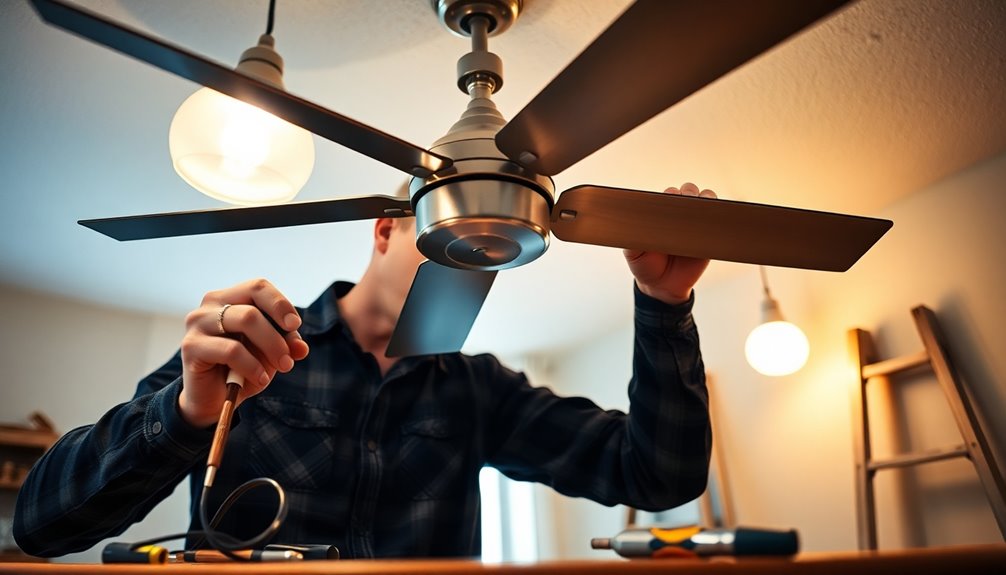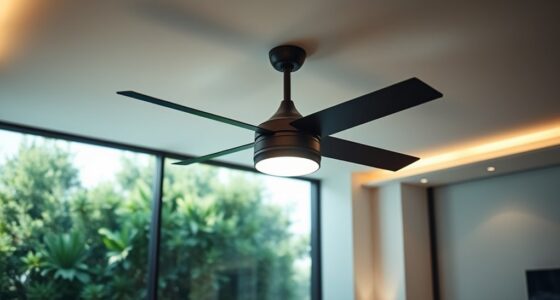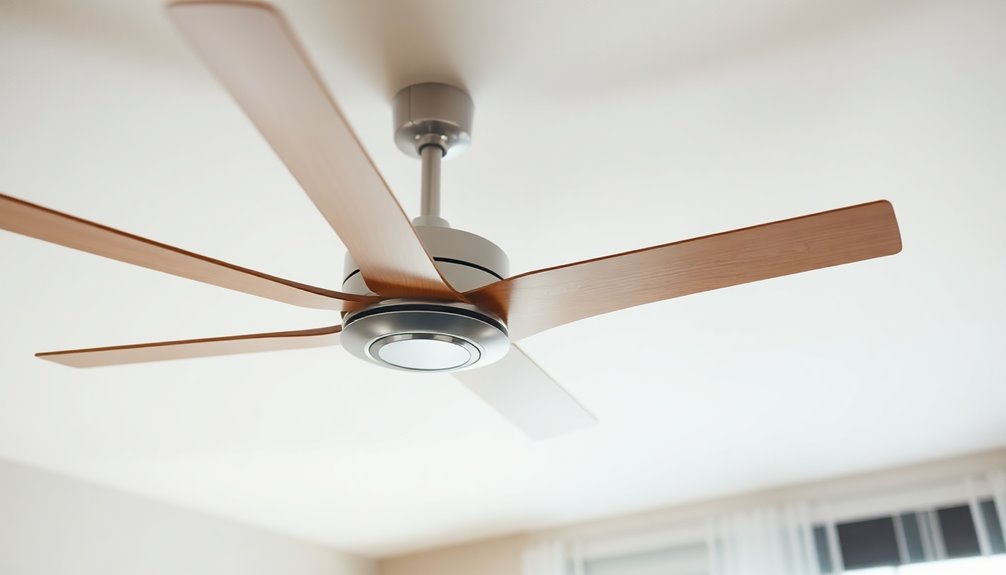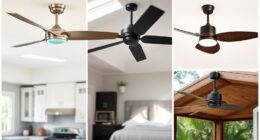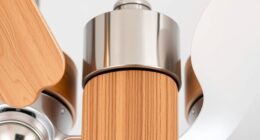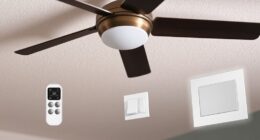To choose ceiling fans for historic homes, focus on authentic styles, finishes, and craftsmanship that match your home’s period character. Look for vintage-inspired fans with ornate details, antique finishes like brass or bronze, and materials such as cast iron or carved wood. Consider your ceiling height for proper mounting and guarantee the size complements your space. Prioritize quiet, energy-efficient options that maintain your home’s charm while offering modern convenience. If you want more tips, keep exploring to find the perfect fit.
Key Takeaways
- Match fan style, finishes, and details to the home’s architectural period, such as Victorian ornate or Craftsman handcrafted designs.
- Select sizes and mounting options suitable for ceiling height and room dimensions for optimal air circulation.
- Choose authentic materials like brass, bronze, or stamped metal with handcrafted embellishments for period accuracy.
- Prioritize quiet, energy-efficient motors with reversible blades and low noise levels to maintain historic ambiance.
- Incorporate period motifs and vintage hardware elements to enhance aesthetic authenticity and cohesive design.
Understanding the Aesthetic and Architectural Style of Your Home

To choose a ceiling fan that complements your home, start by identifying its architectural style. If your house is Victorian, look for fans with ornate metalwork, intricate details, or vintage finishes that reflect that era’s elegance. Incorporating period-appropriate fans can further enhance the historical accuracy and aesthetic appeal of your interior. Additionally, selecting fans that match the period-specific finishes helps maintain consistency throughout your home’s decor. For Craftsman homes, opt for fans with simple, handcrafted designs, showcasing natural materials and clean lines. Observe your interior details, like molding, light fixtures, and hardware, to find design elements that coordinate with period-appropriate fans. Consider the overall proportions and ceiling height to select a fan with the right blade span and mounting style. Avoid modern, sleek fans; instead, select antique or reproduction fixtures that resonate with your home’s historic character. Incorporating self-watering plant pots with vintage or classic finishes can subtly enhance the authentic ambiance of your interior. This approach ensures your ceiling fan enhances your home’s authentic aesthetic.
Selecting Period-Appropriate Designs and Finishes

When choosing a ceiling fan for a historic or vintage-inspired home, selecting period-appropriate designs and finishes is essential to maintain authenticity. Look for vintage ceiling fans with antique finishes like brass, bronze, or distressed metals that mimic early 20th-century hardware.
Choose vintage ceiling fans with antique finishes like brass or bronze to preserve your home’s historic charm.
Focus on fans with ornate blades, decorative motor housings, and vintage-style light kits that reflect the architectural era. Consider finishes in muted or aged tones such as antique copper, patina, or matte black to complement your interior.
Pay attention to craftsmanship details like embossed or etched embellishments that echo early 1900s artistry. Avoid modern minimalistic styles; instead, opt for fans featuring intricate detailing, traditional shapes, and materials consistent with the period.
This approach ensures your ceiling fan enhances your home’s historic charm.
Choosing the Right Size and Scale for Your Space

Choosing the right size and scale for your ceiling fan guarantees it complements your space without overwhelming or underwhelming the room’s proportions.
Measure your room’s square footage to select a fan with an appropriate blade span—29-36 inches for small rooms, 42-48 inches for medium rooms, and 52 inches or larger for big spaces.
For rooms with standard 8-foot ceilings, opt for flush mount or hugger fans to keep the scale balanced.
If your ceilings are higher than 9 feet, choose fans with adjustable downrods for proper clearance and airflow.
Consider the size of furniture and architectural features; a larger fan can act as a focal point, while smaller fans blend seamlessly.
Ensure the blade span stays at least 7-8 feet from walls and obstacles for optimal circulation.
Prioritizing Authentic Materials and Craftsmanship

When choosing a ceiling fan, prioritize authentic materials like brass, bronze, or natural wood to guarantee both beauty and longevity. Incorporate interior design basics such as mood boards and narratives to visualize how the fan will complement your space. Look for handcrafted details such as intricate metalwork or hand-painted accents that reflect true craftsmanship. These elements help preserve your home’s historic charm and guarantee a high-quality, durable fixture.
Selecting Authentic Material Options
Opting for authentic materials in ceiling fans is essential to preserving the character and integrity of a historic home. When selecting period fans, focus on materials that reflect the craftsmanship of the early 20th century. Look for fans with: – Hand-carved wood blades that showcase artisanal skill – Brass or bronze fixtures with aged finishes for an authentic patina – Embossed metal details that replicate vintage decorative elements Genuine period fans incorporate materials like cast iron, stamped metal, and real wood blades, ensuring durability and aesthetic value. Additionally, understanding the Comparative Advantage Principle can help you appreciate the value of choosing high-quality, authentic materials that provide long-term benefits and authenticity, making your home’s restoration both durable and true to its period style. Choosing fans with authentic materials helps your home stay true to its heritage while providing lasting quality, especially when considering material durability and ease of maintenance over time. Recognizing the importance of creative practice can inspire you to seek craftsmen and artisans who specialize in period-appropriate details, ensuring your restoration is both authentic and expertly executed. Incorporating historical craftsmanship into your selection process can further enhance the authenticity of your restoration. Moreover, selecting materials that are true to the original construction methods respects the historical significance of your property, enhancing its overall authenticity and charm.
Appreciating Handcrafted Details
Appreciating handcrafted details in ceiling fans reveals the true artistry behind their design, emphasizing authentic materials and traditional craftsmanship. These fans often feature carefully carved wood, brass, or copper components that highlight durability and period accuracy. Vintage-inspired models may showcase detailed engravings, painted motifs, or regional art forms, reflecting craftsmanship passed down through generations. Artisans use techniques like hand-etching and hand-painting to add intricate decorative elements to blades and motor housings, giving each fan a unique character. Meticulous assembly processes ensure high artisanal standards, making these fans more than just functional fixtures—they’re works of art. Additionally, choosing fans with handcrafted details supports traditional manufacturing techniques, helping to preserve the authenticity and heritage of historic home decor. Selecting such fans helps preserve your home’s historic integrity by honoring authentic materials and period-specific design that define period-specific design.
Matching Fan Blades and Finishes With Existing Décor Elements

To create a cohesive look, choose fan blades and finishes that match your existing colors and architectural materials. Consider how finishes like brass or bronze coordinate with your hardware. Selecting finishes that align with your interior style can enhance the overall harmony of your space. Additionally, consider incorporating antique elements to add character and charm, ensuring your ceiling fan complements your historic home’s unique decor. Opting for unique and wicked planters in your interior decor can also subtly reinforce the vintage or eclectic vibe of your space, creating a more personalized and inviting environment. When selecting blade styles, consider options that reflect electric bike conversion kit components to subtly echo the blend of historic charm with modern engineering, enhancing your room’s aesthetic cohesion. Exploring architectural details can help you select fans that seamlessly integrate into your home’s historic character and preserve its authenticity. Embracing visionary quotes related to design and history can inspire creative ways to enhance your decor choices and celebrate your home’s heritage.
Coordinating With Existing Colors
Matching your ceiling fan’s blades and finishes with your existing décor elements helps create a harmonious space. To achieve this, consider selecting finishes like antique bronze or distressed wood that align with your furniture or trim colors.
You can also opt for finishes such as matte black or aged brass that complement your home’s hardware and fixture palettes, ensuring seamless integration. When coordinating colors, think about your wall or ceiling paint—neutral tones for subtlety or contrasting hues for visual interest.
Keep in mind the historical period of your home; for example, oil-rubbed bronze suits early 20th-century décors. To visualize your choices, use sample swatches or digital tools, making sure your ceiling fans’ finishes blend perfectly with your existing décor elements. Material consistency can also enhance the overall cohesion of your interior design, especially when considering historical accuracy in your selections. Incorporating design harmony helps maintain a unified aesthetic that respects your home’s character. Additionally, understanding the automation trends in home technology can help you select fans with smart features that integrate seamlessly into your home’s ecosystem. Incorporating trends in smart home tech can also provide added convenience and style to your historic space.
Matching Architectural Materials
Selecting ceiling fans that mirror your existing architectural materials guarantees a cohesive look throughout your space. To achieve this, choose fans with blades and finishes that match your architectural materials, such as stained wood blades for historic woodwork or antique brass finishes for vintage fixtures.
Opt for fans with finishes like oil-rubbed bronze, pewter, or aged brass to complement traditional decor elements. Look for detailed craftsmanship and period-appropriate design features, like embossed shades or ornate armatures, to blend seamlessly with authentic architectural details.
Consider custom finishes or vintage-inspired paints and stains to harmonize with original materials like crown molding or paneling. Matching fan blade materials with existing woodwork creates a unified, historically respectful interior aesthetic. Additionally, selecting fans with period-appropriate design features ensures your space maintains its authentic historic charm.
Considering Lighting Options That Complement Vintage Look

When choosing lighting options for a vintage ceiling fan, it’s important to select fixtures that enhance its period-authentic charm. The right light fixture can elevate the vintage aesthetic and provide functional illumination.
Look for light kits that feature antique-style glass shades and finishes like brass, pewter, or aged brass to match your vintage ceiling fans. Consider bulbs such as LED, halogen, or incandescent to maintain the authentic look.
Dimmable options allow you to adjust the ambiance, adding to the nostalgic feel. To guarantee your lighting complements your fan, focus on these details:
- Ornate or embossed glass shades for a classic look
- Antique-style pull chains and decorative fittings
- Finishes like matte black or brushed nickel to match your decor
These choices help preserve the vintage character while providing practical lighting.
Evaluating Ceiling Height and Mounting Compatibility

To guarantee your ceiling fan functions safely and efficiently, it’s essential to evaluate your ceiling height before installation. Measure your ceiling height accurately to determine the best mounting options and ensure proper clearance.
Measuring your ceiling height ensures safe, efficient fan installation tailored to your space.
For ceilings between 8 and 9 feet, a standard downrod keeps blades at the *ideal* height for airflow and safety. If your ceiling is higher than 9 feet, consider adjustable rods or extension kits to maintain proper mounting compatibility and avoid wobbling or noise.
Conversely, for ceilings less than 8 feet, flush mount or hugger fans maximize headroom and prevent obstructions.
Always choose a fan with a motor and blade design suited for your ceiling height to *guarantee* stability, safety, and effective airflow.
Proper evaluation guarantees a seamless, safe installation tailored to your historic home’s architecture.
Opting for Quiet and Efficient Operation to Preserve Ambiance

To keep your space peaceful, look for ceiling fans that operate quietly, like those with DC motors that run at just 20 decibels.
Choosing energy-efficient models with reversible blades and smooth bearings helps minimize noise while reducing your energy bills.
Proper installation at the right height also guarantees your fan runs silently without wobbling or rattling.
Prioritize Low Noise Levels
Choosing ceiling fans with low noise levels is essential for maintaining the peaceful ambiance of historic homes. Fans operating at decibel levels below 50 dB ensure minimal disruption, preserving the home’s tranquility.
Look for models with DC motors, as they offer quieter, more energy-efficient, and smooth operation. Additionally, selecting fans with rubberized or insulated mounting components can considerably reduce vibrations and operational noise.
Modern fans often feature variable speed settings and whisper-quiet technology, giving you precise airflow control without disturbing the environment.
When installing, ensure secure mounting and balanced blades to prevent wobbling and extra noise.
Prioritizing low noise helps you enjoy comfort without compromising the historic home’s serene atmosphere. Your careful choice guarantees quiet operation that complements the home’s timeless charm.
Choose Energy-Efficient Models
Opting for energy-efficient ceiling fans not only cuts down your electricity bills but also helps preserve the tranquil atmosphere of your historic home. Choosing models with Energy Star certification ensures you get maximum energy efficiency and reliable performance. These fans often feature DC motors that consume 70% less power than traditional AC models, reducing costs and environmental impact. Additionally, quiet operation is a hallmark of modern energy-efficient fans, with many producing noise below 35 decibels. High airflow efficiency (CFM per watt) guarantees effective circulation without excess energy use. Focus on sleek designs that blend seamlessly with your home’s historic character. Use the table below to compare key features:
| Feature | Benefit |
|---|---|
| DC Motor | Low power consumption, quiet operation |
| Energy Star Certification | Guaranteed energy efficiency |
| Variable Speed Settings | Custom comfort, energy savings |
| Programmable Timers | Convenience and reduced energy waste |
| Stylish, unobtrusive design | Preserves historic ambiance |
Opt for Reversible Fans
Reversible ceiling fans offer versatile airflow management that enhances comfort year-round without disrupting your home’s historic charm. By choosing quiet reversible fans, you guarantee smooth operation that minimizes noise, preserving your home’s ambiance.
These fans feature motors that switch blade direction seasonally, improving efficiency and comfort. In summer, blades rotate counterclockwise to create a cooling breeze, while in winter, clockwise rotation helps distribute warm air near the ceiling.
Look for reversible fans with high-quality, balanced blades to reduce vibration and noise. Energy-efficient motors can lower power consumption without sacrificing performance.
When selecting a reversible fan, consider these features:
- Quiet operation for minimal noise
- Efficient motor for energy savings
- Balanced blades for seamless, vibration-free movement
Incorporating Historical Details in Fan Design and Hardware

Incorporating historical details into fan design and hardware helps create an authentic vintage ambiance that complements your home’s architectural style. Look for fixtures with period-appropriate motifs like Edwardian urn arms, embossed shade holders, or hand-painted murals reflecting early 20th-century craftsmanship. Hardware finishes such as antique brass, patina, or oil-rubbed bronze deepen the vintage feel, matching the aged look of your home. Reproduction fans often feature intricate detailing and decorative elements that mimic original designs, preserving the era’s aesthetic. Authentic hardware—finials, pull chains, decorative blades—crafted from wood or metal with vintage-inspired finishes ensures seamless integration into your historic interior.
| Element | Material/Finish | Style Inspiration |
|---|---|---|
| Finials | Brass, bronze, wood | Victorian or Edwardian |
| Pull Chains | Antique brass, patina | Early 20th-century details |
| Blade Design | Carved wood, metal | Ornate, period-appropriate |
Balancing Modern Functionality With Historic Charm

While maintaining the vintage charm of your home’s interior, modern ceiling fans can seamlessly blend functionality with classic design. You can select vintage or reproduction fans with period-appropriate details, finishes, and materials to preserve your home’s historic aesthetic while ensuring ideal airflow.
To keep the visual integrity intact, consider discreet, low-profile fans or those hidden behind decorative elements. Look for fans with subtle finishes like antique brass or matte black, which complement traditional decor without clashing.
Reversible blades and vintage-inspired detailing give you versatility in airflow direction and style. Key options include:
- Vintage or reproduction fans with period-appropriate design
- Discreet, low-profile fans or those hidden behind decor
- Fans with subtle finishes like antique brass or matte black
These choices balance modern features with authentic style, ensuring your home remains both functional and charming.
Frequently Asked Questions
What Is the Rule of Thumb for Ceiling Fans?
The rule of thumb for ceiling fans is to install them at least 7 feet above the floor, with 8-9 feet being ideal for good air circulation.
For rooms with higher ceilings, use downrods to position the fan so blades are about 8-10 inches below the ceiling.
In small rooms, choose fans with a 36-42 inch span, while larger spaces need bigger fans for proper airflow.
How Do I Know Which Ceiling Fan to Get?
You might worry about finding a fan that matches your home’s charm, but focus on selecting one that fits your style and space. Look for vintage-inspired designs in finishes like antique brass or wood, with blade spans of 36-48 inches for your room size.
Choose controls that blend with the period decor, and prioritize energy-efficient, reversible motors to keep your home both authentic and functional.
Do Ceiling Fans Need to Match Throughout the House?
You might wonder if ceiling fans should match throughout your house. While keeping finishes consistent, like antique brass or matte black, helps create harmony, you don’t need perfect matches.
Varying styles can highlight architectural details or different periods, adding charm. Focus on cohesive design elements—such as blade shape or decorative touches—and balance authenticity with practicality.
This approach lets your home feel unified yet unique in each space.
Do You Need a Special Ceiling Fan for Vaulted Ceilings?
You do need a special ceiling fan for vaulted ceilings. These fans have longer downrods, often 24 inches or more, to provide enough clearance.
They also feature angled mounts to fit ceiling slopes of 30 degrees or higher.
Look for models with reversible blades, sturdy brackets, and heavy-duty motors.
Larger blades, up to 72 inches, are ideal for circulating air effectively in spacious, vaulted rooms.
Conclusion
Choosing the perfect ceiling fan for your historic home is like finding the right piece in a timeless puzzle. By honoring its unique style and details, you’ll seamlessly blend function with charm, creating a harmonious space that respects the past while serving the present. Take your time, and let your home’s character guide your choices—because the right fan isn’t just an accessory, it’s the heartbeat of your home’s story.


